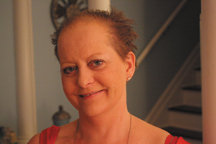On St. Patrick’s Day last year, Scarlett Margetanski of Bayonne received news she dreaded hearing: Her cancer had returned.
Already considered terminal even when tests show that she is currently cancer free, Margetanski understood that the cancer would keep returning – a fact of life she has come to accept, even when it causes her to break down in tears.
“But I’ve never given up,” she said, “and that’s what I want people to understand if they come down with cancer – not to give up.”
For Margetanski, this has been a lifelong battle that started with childhood cancer, a battle she has fought both as a victim of the disease and as a caregiver fighting to save the life of her husband, who has a different kind of cancer.
“I have come close to being six feet under or pushing up daises more times than I care to remember.”— Scarlett Margetanski
________
“Miracles make you want to give back like hell,” she said. “We really want more caregivers and survivors to come to the relay this year. I personally want to help the underserved women of Hudson County. I realize how lucky I am to have insurance, and I know that the poor and minorities have a completely different life than me.”
A victim of two primary cancers as well as a caregiver, Margetanski said she understands how lucky she is to be alive, and that other people do not have the same opportunities she has.
“I have come close to being six feet under or pushing up daises more times than I care to remember,” she said. “However, some of these women do not have a chance to get a mammography, don’t have health insurance, and don’t know their family history.”
A lifelong struggle
Now 45 years old, Margetanski was diagnosed at age 10 with a rare childhood cancer often referred to as PNET. She was treated with chemo and cobalt radiation, and was put into remission.
In 1999, her husband was diagnosed with testicular cancer and Non-Hodgkin’s Lymphoma, which spread to his lungs and the spinal fluid surrounding his brain. Scarlett became his most ardent supporter, working through the medical care system to keep him alive.
In 2004, Scarlett was again diagnosed with cancer, this time bilateral breast cancer that required her to undergo 14 hours of surgery, a bilateral mastectomy with immediate reconstruction, followed by a complete hysterectomy. Shortly after, she was experiencing blackouts. After an MRI of her brain, she was diagnosed with breast cancer metastasis to the spinal fluid in her brain.
By sheer will or grace of God, Margetanski was able to recover, but not without a significant medical side effect. The chemicals used to fight the cancer caused congestive heart failure – a fact she found out in 2006 when she was rushed to the hospital again and discovered her heart functioned at 20 percent of normal capacity.
A year later, she suffered blackouts and absent seizures, as if she was falling asleep with her eyes open. These symptoms were later treated with medication.
Then just prior to St. Patrick’s Day in 2010, she received the bad news. Doctors told her she had 30 days to live. Intensive therapy over the next six months again saved her life so that by late August, she was pronounced cancer-free.
This does not mean she is without pain or free of medical problems. In October, she was admitted to Memorial Sloan-Kettering Cancer Center for pneumonia. In February, the mediport – a device through which chemotherapy is administered to her – became infected, once more bringing her to death’s door.
“I’m terminal,” she said, meaning that the cancer will eventually kill her. “But I intend to go on fighting to stay alive, and that’s the message I want to convey with this year’s Relay for Life.”
Relay for Life is a fundraising event designed to provide money for research and help victims of cancer.
“At the event, our team will camp out overnight and will take turns walking around the track to raise money and awareness to help the American Cancer Society create a world with less cancer and more birthdays,” she said.
People can sponsor Margetanski by visiting her Web site at main.acservents.org/goto/ScarlettFever.
Part of it is attitude, she said, which is one of the reasons why she dresses up in bright clothing and wears brightly colored wigs.
When she walks down the street, people look at her. Some even know that this is part of her fight for life. More importantly, bright colors also help to generate hope and energy inside of her. By broadcasting this, she hopes to show other people they can fight to stay alive and still feel good about themselves.
“I want people to look at me and realize that they can. My life is a blessing,” she said. “Although sometimes I feel cursed with this disease, I know I have been blessed with life. I just don’t know why I was blessed.”
Al Sullivan may be reached at asullivan@hudsonreporter.com.
